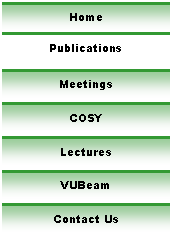
|
Reprint Server |



Proceedings, FFAG 2009 International Conference, Fermilab, Illinois
Preface
Fueled by recent advances, electron, proton and heavy ion accelerators are playing increasingly important roles in science, technology, and medicine including accelerator-driven subcritical reactors, industrial irradiation, material science, neutrino production, and cancer therapy. The drive for higher beam power, high duty cycle, high reliability and precisely controlled beams at reasonable cost has generated world-wide interest in Fixed-field Alternating Gradient accelerators (FFAGs). Fixed-field accelerators have the automatic advantage, or potential, to realize all of these desirable features using inexpensive, DC power supplies and various modes of acceleration. FFAGs are unique in their high repetition rates and large acceptances characteristic of cyclotrons, yet they also embody the advantages of the synchrotron: focusing is predominately "strong," with low injection and extraction losses. With the best features of the cyclotron and synchrotron combined, the FFAG accelerators represent new directions in accelerator science and are presently under international development. Strong interest worldwide has emphasized FFAGs for hadron therapy [RACCAM in France and PAMELA in the U.K.], in the context of proton and carbon accelerators, but other areas are gaining momentum: high intensity proton FFAGs for Accelerator Driven Subcritical Reactors (ADSR) and compact electron FFAGs for inspection systems such as cargo scanning. The elimination of pulsed operation which complicates and increases the expense of machines and restricts the delivered rate or beam power, makes the FFAG an ideal machine for industry, medical, and commercial applications. Further, recent advances in design, such as isochronous operation, will give the FFAG a distinct advantage in many applications, notably for medical and high-intensity applications. The FFAG stands to compete with the cyclotron, which is the current industrial and commercial standard. Commercial FFAG versions are already under development in Japan at Mitsubishi Corp. and NHV Corp.
The novel dynamics and potential have been the subject of intensive study, development and simulation as documented in a series of workshops held alternately in Japan, the U.K., France, Canada, and the U.S. (FFAG'99-FFAG'10), with the next workshop, FFAG11 scheduled to be held at Oxford University, Sept. 12-17th. FFAG09 boasted over 50 participants including a large international contingent of renowned accelerator physicists from the U.K., Japan, France, Germany, and Canada. In addition to universities, major large accelerator laboratories in the U.S. were also represented and included Brookhaven National Laboratory, Argonne National Laboratory, and Lawrence Berkeley National Laboratory. Industrial participation included Siemens, Passport Systems, IBA, and Sumitomo with a paper being submitted to the proceedings by Passport Systems.
C. Johnstone, M. Berz, P. Snopok (Eds.), International Journal of Modern Physics A 26,10-11, World Scientific, 2011, DOI 10.1142/S0217751X11053079
Download
Click on the icon to download the corresponding file.
![]() Download Adobe PDF version (24808993 Bytes).
Download Adobe PDF version (24808993 Bytes).
Go Back to the reprint server.
Go Back to the home page.
This page is maintained by Kyoko Makino. Please contact her if there are any problems with it.